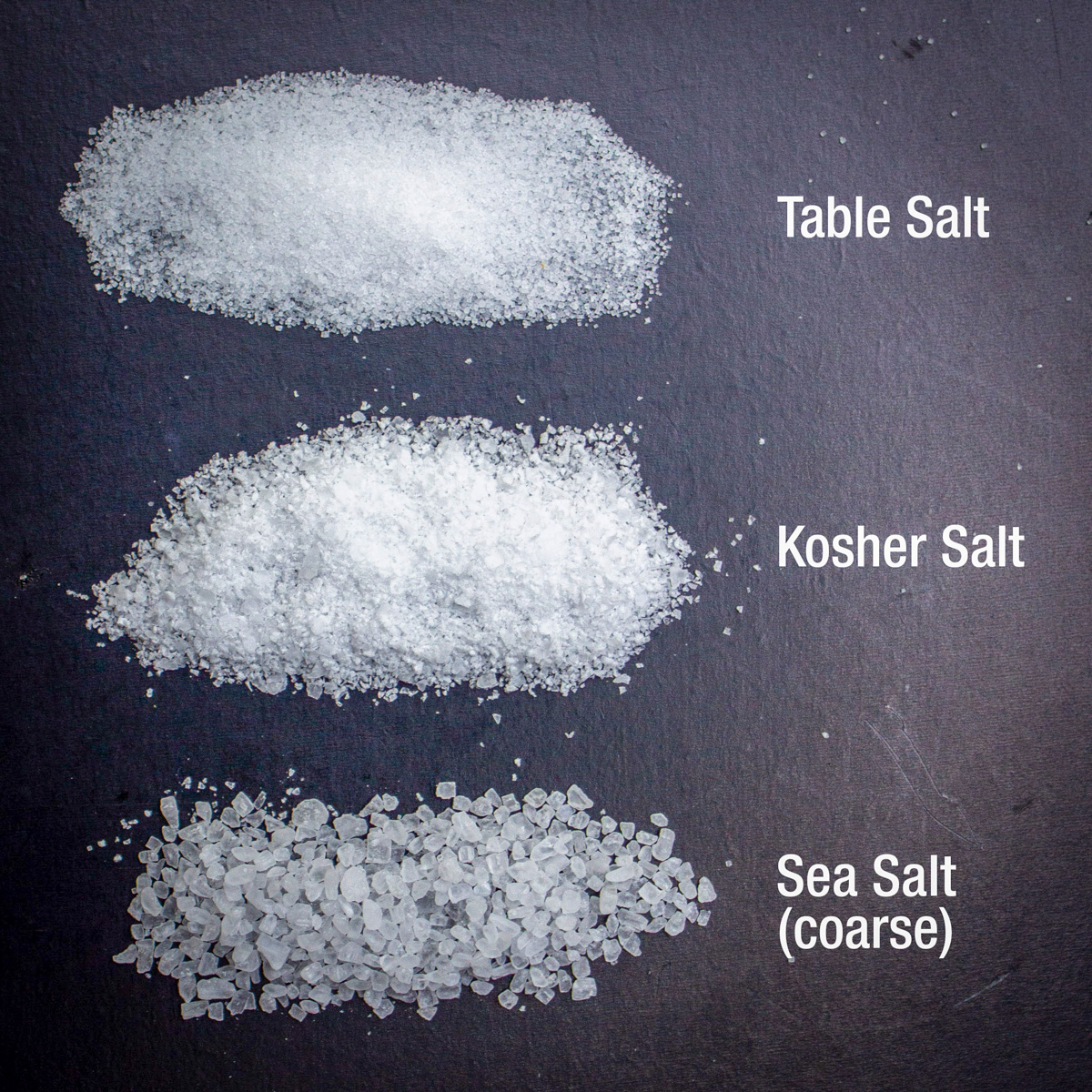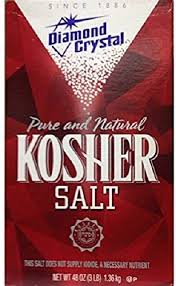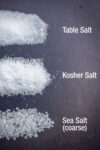Best Salt For Cooking (and what you should know)
What is the best salt for cooking? We did the research to give you the essential facts, which salt to use for what, the cooking salt most chefs use and how to use salt in a recipe.
Salt is king when it comes to seasoning. Many would say it is THE most important ingredient in your pantry, but all salts are not created equal and they are not interchangeable.

Salt is the common name for sodium chloride. There are a lot of articles out there explaining the science, the health impact, food guideline limits, the level of ‘saltiness’ of different kinds of salt, what type of salt to use for what type of cooking and chef favorites.
We are focusing on practical day-to-day cooking with salt for the home cook and what the experts seem to agree on – not gourmet salt and not the science. In short, just the basics you should know. References are listed below.
So what’s in your salt shaker? And what should be?
Chefs #1 choice

Most chefs agree that the best salt for general cooking is Kosher salt, particularly Diamond Crystal Kosher Salt * because:
- you are less likely to over salt with it (it’s less salty)
- it pinches easily
- it dissolves well, and
- it’s easy to sprinkle
* find it at your local grocery store or on Amazon. We have no association with them.
Top 3 types of salt and their uses
| Salt | BEST TYPE OF SALT FOR | Characteristics |
|---|---|---|
| Table salt | cooking/baking where precise measurements are needed and to season pasta water | -all purpose salt – has added iodine to prevent iodine deficiency -refined from rock salt |
| Kosher salt | seasoning meat and poultry and sprinkling on vegetables | -all purpose salt -dissolves quickly -flakier and coarser -from sea water or salt mines |
| Sea salt | finishing salt (especially flaked) used for sprinkling on foods and desserts for a burst of flavor. | -more expensive -specialty salts: Maldon sea salt flakes, French fleur de sel, Celtic sea salt. -comes in coarse salt, fine sea salt or flake salt -from evaporated sea water |
Some cooks also use pink Himalayan salt or black Himalayan salt like kala namak. These are finishing salts that add wonderful umami flavor to cooked food or salts used to rim drinks. They are the purest form of salt and rich in mineral content.
Which salt is saltiest
measured by sodium level
TABLE SALT – saltiest
SEA SALT – almost the same as table salt, just a touch less sodium
KOSHER SALT – 23% less salty than table salt (Diamond Crystal Kosher salt is ~60% less salty). Less salty means less sodium.
Does the brand of salt matter?
Yes, brands can make a difference. For example 1 Tablespoon regular table salt = 1 1/2 Tablespoons Morton’s Kosher salt = 2 Tablespoons Diamond Crystal Kosher salt (or Maldon sea salt).
Using salt in a recipe
This can be tricky because, as we’ve seen, all salts are not equal in saltiness. Even all kosher salts do not have the same amount of sodium.
Here’s some advice from chef and cookbook author, Bonnie Stern.
“Home cooks should check the labels on your box of salt whatever kind you are using. It helps to use the same brand of salt all the time so that you get used to its salty ‘power’ and know how much to use.
Recipes in many cookbooks now call for Diamond Crystal Kosher Salt, so assume they are using that and, if you are using another brand (or table salt or sea salt), use less – you can always add more later”
Bonne Stern
When should you add salt during cooking?
According to Cooks Illustrated, you will get the most even seasoning and well-rounded flavor if you add salt at the beginning of the cooking process.
If you are watching your salt intake, salt your food at the end with less salt, adding small amounts as needed.
If you forget to add it at the beginning, add it at the end, but not the full amount called for in the recipe. Start with much less and add a little bit at a time.
Foods high in salt
- Processed meat – bacon, ham, sausages
- Cheese
- Bread – sandwich, baguettes
- Soups – canned, frozen, from powdered or paste bases
- Olives, pickles
- Salted snacks – chips, nuts, crackers, fries
- Soy sauce
- Condiments – ketchup, mayo, BBQ sauce
- Smoked meats and fish
A couple of examples may be surprising:
- A single slice of bread contains anywhere from 80-230 milligrams of sodium.
- Some breakfast cereals can contain up to 300 milligrams of sodium before milk is added.
- According to WebMD, just 1 tablespoon of soy sauce contains nearly 40% of the daily recommended 2,300 milligrams of sodium. Choose low sodium soy if you want less salt. Light soy sauce just refers to a thinner and lighter colored soy sauce, not the sodium content.
Remember that the recommended amount of salt per day is between 1500-2300 mg of sodium – less than a teaspoon.
Food labels
Food labels can be confusing. Here’s a guide to help understand what you’re buying. Labelling may be different in different countries, but generally:
- Unsalted – means no salt added (although salt can be natural to some foods)
- Sodium-free or salt free – means a serving has less than 5 mg of sodium.
- Low-sodium or low salt – means a serving has 140 mg or less of sodium.
- Reduced sodium – means the food has 25% less sodium per serving than usual.
Salt FAQ
It’s the common name for sodium chloride, made up of 40% sodium and 60% chloride.
The American Heart Association recommends 1500 mg a day (less than a teaspoon). Many food guidelines suggest less than 2300 mg a day. Salt does have some important benefits. It helps to balance fluids in our body, make our nerves work properly and digest food.
On average, Americans consume 3400 mg per day (more than double what we need) according to the FDA (Food and Drug Administration).
– 75% from restaurant and processed foods
– 11% from adding it during cooking or eating
– 14% occurs naturally in foods.
source: American Heart Association
According to Healthline, salt can increase blood pressure, but there is no good evidence that salt reduction has any effect on the risk of heart disease or death for the general population. Some groups, however, may respond to salt differently. Salt is necessary for health and an intake that is too low can negatively impact health.
Quick summary
- Salt is an important flavor enhancer. It brings out the natural flavors in food.
- Different types of salt and brands have varying degrees of ‘saltiness power’, varying levels of sodium content and are used for different purposes in cooking.
- Most chefs use kosher salt for general all purpose cooking, particularly Diamond Crystal Kosher Salt. It’s the workhorse in restaurants.
- If you are not sure what type of salt to use in a recipe, use less to begin with during cooking, then add more at the end if needed.
- Americans tend to use a lot more salt per day than needed or recommended by food guidelines. Learn to read labels if you are watching your salt intake.
References
Healthline, American Heart Association, Serious Eats, A Beautiful Plate, The Spruce Eats, Wide Open Eats, Smitten Kitchen, Bon Appétit.
Check out the Two Kooks In the Kitchen recipe index. Needless to say, almost every recipe uses salt!
And if you need a refresher on fresh herbs – how to make them last longer, how to cook with them, how to freeze etc, check out our post on Herb Basics for Cooking Purposes.


ALL YOU HEAR IS UR USING TOO MUCH SALT .. THEN PLEASE TELL ME WHY THEY DON’T MAKE “COLORED ” SALT SO U CAN SEE HOW MUCH UR USING ??? ALWAYS WONDERED …
Interesting idea (although I suspect most of us don’t want to see how much we use)